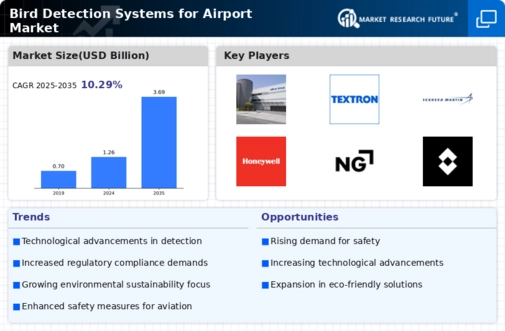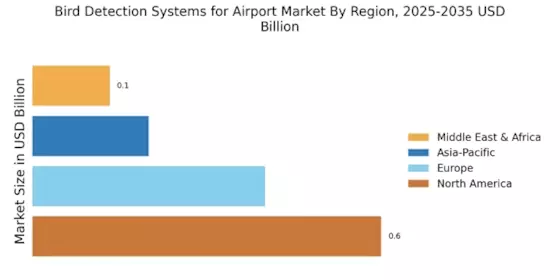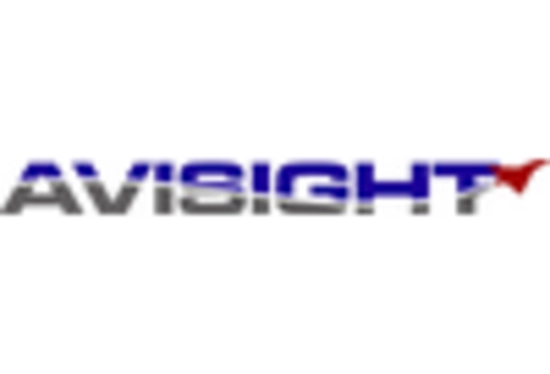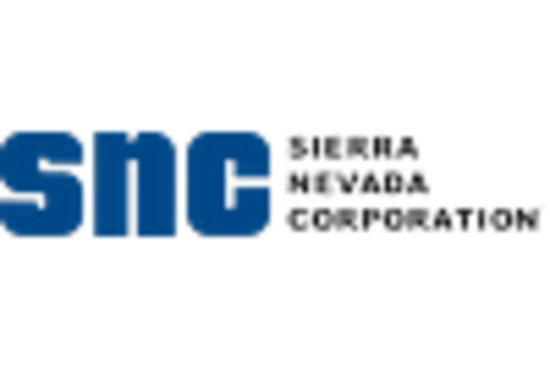The Bird Detection Systems for Airport Market is characterized by a dynamic competitive landscape, driven by the increasing need for enhanced safety measures in aviation. Key players are actively innovating and expanding their operational capabilities to address the growing concerns regarding bird strikes, which pose significant risks to aircraft safety. Companies such as Bird Control Group (NL), DeTect Inc. (US), and AeroVironment (US) are at the forefront of this market, each adopting distinct strategies that collectively shape the competitive environment. Bird Control Group (NL) focuses on integrating advanced technology into their bird detection systems, emphasizing real-time data analytics and user-friendly interfaces. Meanwhile, DeTect Inc. (US) has been enhancing its product offerings through strategic partnerships, thereby broadening its market reach and technological capabilities. AeroVironment (US) is leveraging its expertise in drone technology to develop innovative solutions for bird detection, indicating a trend towards the incorporation of unmanned systems in wildlife management.
The business tactics employed by these companies reflect a concerted effort to optimize supply chains and localize manufacturing processes. The market appears moderately fragmented, with several players vying for market share while also collaborating on technological advancements. This competitive structure allows for a diverse range of solutions, catering to various airport sizes and operational needs. The collective influence of these key players fosters an environment ripe for innovation, as they continuously seek to enhance their offerings and improve operational efficiencies.
In August 2025, Bird Control Group (NL) announced a partnership with a leading airport authority to implement its latest bird detection technology, which utilizes AI-driven analytics to predict bird movements. This strategic move not only enhances the safety protocols at the airport but also positions Bird Control Group as a leader in the integration of artificial intelligence within bird detection systems. The partnership is expected to serve as a model for future collaborations, potentially influencing industry standards.
In September 2025, DeTect Inc. (US) launched a new version of its radar-based bird detection system, which features improved sensitivity and range. This upgrade is particularly significant as it addresses the growing demand for more reliable detection systems in high-traffic airports. By enhancing its product line, DeTect Inc. reinforces its commitment to innovation and positions itself competitively against emerging technologies in the market.
In July 2025, AeroVironment (US) unveiled a drone-based bird monitoring system that integrates real-time data collection with advanced analytics. This development is noteworthy as it reflects a shift towards utilizing drone technology for wildlife management, potentially revolutionizing how airports approach bird detection. The strategic importance of this innovation lies in its ability to provide comprehensive situational awareness, thereby improving safety measures and operational efficiency.
As of October 2025, the competitive trends in the Bird Detection Systems for Airport Market are increasingly defined by digitalization, sustainability, and the integration of artificial intelligence. Strategic alliances among key players are shaping the landscape, fostering collaboration that enhances technological capabilities. Looking ahead, it is likely that competitive differentiation will evolve, with a pronounced shift from price-based competition to a focus on innovation, technology, and supply chain reliability. This evolution suggests that companies will need to prioritize research and development to maintain a competitive edge in an increasingly complex market.

















Leave a Comment